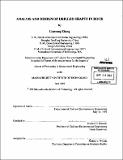Analyis [sic] and design of drilled shafts in rock
Author(s)
Zhang, Lianyang, 1964-
DownloadFull printable version (33.13Mb)
Alternative title
Analysis and design of drilled shafts in rock
Other Contributors
Massachusetts Institute of Technology. Dept. of Civil and Environmental Engineering.
Advisor
Herbert H. Einstein.
Terms of use
Metadata
Show full item recordAbstract
Drilled shafts are widely used to transfer heavy structural loads (both axial and lateral) through the overburden soil to the underlying rock mass. It is important to consider the effect of discontinuities when designing drilled shafts in rock. This thesis develops (1) a new design method for axially loaded rock-socketed shafts; (b) new design methods for laterally loaded rock-socketed shafts; and (c) a method for assessing the three dimensional (30) geometric characteristics of discontinuities. The new design method for axially loaded rock-socketed shafts concentrates on the prediction of the ultimate side shear resistance and the end bearing capacity. New relations have been developed for both the side shear resistance and the end bearing capacity. Both developments are derived from the analysis of ex.tensive databases. For laterally loaded rock-socketed shafts, a simplified design method and a detailed design method were developed. The simplified design method assumes that the rock mass is isotropic and uses an elasto-plastic continuum model to predict the load-displacement response. This model can consider drilled shafts in rock overlain by soil and it was validated by comparing its results with available theoretical solutions and field test data. The detailed design method considers the effect of anisotropy of jointed rock masses. The key components of this method are the 30 geometric characterization of discontinuities and the estimation of the anisotropic defonnation and strength properties of jointed rock masses. The 30 characterization of discontinuities uses the observed trace data in a finite circular window (on an exposed outcrop or at the bottom of a shaft hole) to determine the corrected trace length distribution, the discontinuity size (diameter) distribution, the total number of discontinuities in an objective volume, and finally the fracture tensor which describes the intensity and orientation of all discontinuities in a rock mass. The method for estimating the anisotropic elastic deformation properties uses the superposhion-principle and adopts an equivalent continuum approach. Hill's criterion is used to describe the anisotropic yield/failure of jointed rock masses. The method was then applied to examine the effect of anisotropy on the lateral deformation of rock-socketed shafts. Also, design charts were developed for considering the effect of anisotropy when predicting the elastic defonnation of laterally loaded rock-socketed shafts. Finally, the applicability of the recommended design methods is discussed and a design example is presented.
Description
Thesis (Ph.D.)--Massachusetts Institute of Technology, Dept. of Civil and Environmental Engineering, 1999. Includes bibliographical references (p. 713-732).
Date issued
1999Department
Massachusetts Institute of Technology. Department of Civil and Environmental EngineeringPublisher
Massachusetts Institute of Technology
Keywords
Civil and Environmental Engineering.